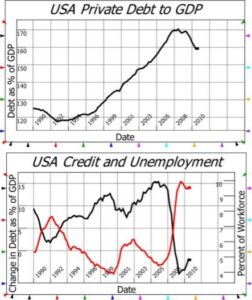The fantasy economics of the Nobel prize
How banks create money Steve Keen
Economics students are taught that banks lend money that comes from the deposits of their customers. In other words, banks just circulate money passing it from those who save, to those who borrow. This, however, completely misunderstands how the commercial banks actually work: by creating new money when they give out loans. This year’s “Nobel” Prize in Economics, however, was awarded “for research on banks and financial crises”, to three economists whose models continue to understand banks, debt, and money as though through the eyes of naive students of economics, argues Steve Keen.
Fifteen years ago, when the Global Financial Crisis that I and a handful of other rebel economists had warned about began, I really thought there was a chance for a revolution in economics.

In particular, mainstream economics had left the monetary system – that is, the banks and other institutions that support and regulate the creation and exchange of money out of its macroeconomic models, with a naive assumption that money was just a “veil over barter” and should therefore be ignored in macroeconomics. In contrast, the contrarian theory I followed — known as Hyman Minsky’s “Financial Instability Hypothesis”— argued that private debt and credit (the annual change in debt) are crucial. As I put it in May 2007:
“At some point, the [private] debt to GDP ratio must stabilise and on past trends, it won’t stop simply at stabilising. When that inevitable reversal of the unsustainable occurs, we will have a recession. (“Booming on Borrowed Money”)”
That reversal occurred in almost all OECD nations, as did the recession I predicted it would cause (Figure 1 shows the data for the USA).
An essential element in the theory of Minsky is that bank lending creates money, and that when this money is spent, it adds to aggregate demand. As Minsky put it:
“ For real aggregate demand to be increasing … it is necessary that the current spending plans … be greater than the current received income … For such planned deficits to succeed in raising income … it is necessary for some of the spending to be financed … by the creation of new money.” (Minsky 1982, p. 6)
This explanation that banks are not “mere intermediaries” between savers and borrowers, but actually create money when they lend, had been part of non-mainstream economics for decades (Schumpeter 1934; Moore 1979; Fisher 1933), but the mainstream had always resisted it. Then in 2014, the Bank of England came out on the side of the rebels:
“ The reality of how money is created today differs from the description to be found in some economics textbooks: Rather than banks receiving deposits when households save and then lending them out, bank lending creates deposits “ (McLeay, Thomas and Radia; 2014, p14).
The tide was turning, it seemed: just as Copernicus’s realistic Sun-centric model of the solar system came to supplant Ptolemy’s false Earth-centred vision, maybe, finally, economics was going to cease being about fantasy worlds, and start trying to understand the one in which we actually live.

Fat chance! The latest “Nobel Prize” in Economics was awarded to three economists -who don’t happen to have banks, debt or money in their economic models -“for research on banks and financial crises”. Giving it to one of them Ben Bernanke was, for me, the last straw. The academic paper for which his phoney Nobel was awarded
includes this outright dismissal of Irving Fisher’s “Debt-Deflation Theory of Great Depressions” (Fisher 1933): “ Fisher’s idea was less influential in academic circles, though, because of the counterargument that debt-deflation represented no more than a redistribution from one group (debtors) to another (creditors). Absent implausibly large differences in marginal spending propensities among the groups, it was suggested, pure redistributions should have no significant macro-economic effects.” (Bernanke 2000, p24. Emphasis added)
I normally focus on the second italicized phrase, which is provably wrong (Keen 2021, pp69-74) — and a glance at the bottom graph in Figure 1 makes it obvious that credit has extremely significant macroeconomic effects. But let’s not ignore the first highlighted phrase, where Bernanke says a debt-deflation is “no more than a redistribution from … debtors to … creditors”. This is complete nonsense. Debtors go bankrupt during a debt-deflation, and they therefore can’t repay their debts: it’s not a redistribution, but an outright decline in overall wealth and spending power.
The great physicist Wolfgang Pauli once described a student’s work as being so bad that it was “not even wrong”. The paper at issue here, for which Bernanke was given a Nobel Prize was, to my mind, so bad that it was “not even banal”.
The “scientific background” paper that was issued by the Nobel committee to justify this prize, entitled “Financial Intermediation and the Economy”, also completely ignores the literature on how banks create money — including the key paper by the Bank of England (McLeay, Radia, and Thomas 2014), as well as a similar one by the Bundesbank (Deutsche Bundesbank 2017).
The economics discipline prefers to remain in fantasy land, ignoring realworld experience and far more realistic explanations. It’s as if the Catholic Church not merely tried Galileo, but also destroyed all knowledge of his telescope. If they had, humanity might never have escaped the Dark Ages.
Mainstream economists, it seems, are happier in the dark than in the light.
This article first appeared in the Institute of Arts and Ideas news, on 22 October 2022
1. https://iai.tv/articles/the-fantasy-economics-of-the-nobel-prize-auid-2279
Prof Steve Keen is an ERA patron



























